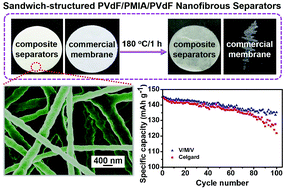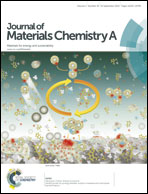Sandwich-structured PVdF/PMIA/PVdF nanofibrous separators with robust mechanical strength and thermal stability for lithium ion batteries†
Abstract
Novel, sandwich-structured PVdF/PMIA/PVdF nanofibrous battery separators with robust mechanical strength and thermal stability are fabricated via a sequential electrospinning technique. The nanofibers of the PVdF and the PMIA layers are bonded and interconnected on the interface boundary without any polymer binder or post-treatment. Benefiting from the high porosity of the as-prepared membranes and the introduction of PMIA, the PVdF/PMIA/PVdF composite membranes exhibit high ionic conductivity (2.3 times higher than that of the Celgard membrane), robust tensile strength (13.96 MPa), and excellent thermal stability, sustaining insulation after closing the pores in the PVdF layer. Hot oven testing reveals that the composite membranes exhibit no dimension shrinkage after being exposed to 180 °C for 1 h. Furthermore, the as-prepared-membrane-based Li/LiCoO2 cell shows a higher capacity retention of 93.10% after 100 cycles and better rate performance compared with the cell using the Celgard membrane, providing new insight into the design and development of high-performance rechargeable lithium ion batteries.


 Please wait while we load your content...
Please wait while we load your content...